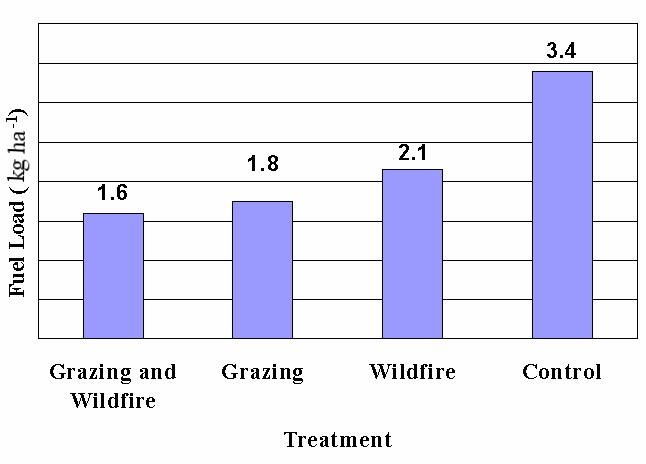Historic fire suppression efforts have interrupted the natural fire cycle allowing fuel loads to reach unprecedented levels. Recent catastrophic wildfires, such as those seen in Idaho, Montana, Colorado, and Arizona, have the potential to produce extremely intense and severe burns.
![fire.Par.85308.Image.-1.-1.1[1] fire.Par.85308.Image.-1.-1.1[1]](http://ucanr.org/blogs/LivestockRangeTopics/blogfiles/8122.jpg)
While these fires reduce fuel load, they may also sterilize soils (Wells et al. 1979). These extensive fires may result in loss of biodiversity and the destruction of critical habitat for native plants and animals, which often leads to invasion by invasive species. Given last year’s highly productive grass season, California and the North Coast are at risk for wildfire.
Grazing may reduce fire hazard. Prescribed grazing has the potential to be an ecologically and economically sustainable management tool for reduction of fuel loads. Existing data indicate there are two ways by which grazing impacts the fuel load: removal of vegetation, and hoof incorporation of fine fuels (Nader, et. al., 2007). Fuel management studies have shown that spread rate and flame length decrease as dry grass fuel loads decrease (Scott and Burgan 2005). Livestock grazing may modify the effects of fire in various ways, often by reducing the fuel load (Collins 1987; Noy-Meir 1995).
Diamond, et.al. (2009) showed that targeted grazing in Idaho reduced Cheatgrass (Bromus tectorum) biomass and cover, which resulted in reductions in flame length and rate of spread. When the grazing treatments were repeated on the same plots in May 2006, Cheatgrass biomass and cover were reduced to the point that fires did not carry in the grazed plots in October 2006.
Additional Idaho researchers, Weber, et. al. (2011), showed that livestock grazing was the most effective means to reduce fuel load (P < 0.0005) compared to recent wildfire (P < 0.05) and livestock grazing with previous wildfire (P < 0.05). See the graph at the end of this post. Livestock grazing provides a viable management tool for fuel load reduction prescriptions that avoids the negative effect of extreme fire intensity where fuel load is high.
Additionally, grazing reduces fuel load in a more selective fashion (Archer 1999) avoiding the potential sterilizing effect that an extremely intense fire may have on soil. Studies in other regions have reported results that corroborate well with the Idaho findings. Within montane forests of Zion National Park, Madany and West (1983) considered livestock grazing the primary factor in the reduction of herbaceous cover. Tsiouvaras et al. (1989)reported that grazing by goats effectively reduced 1- and 10-hour fuel load in coastal forest areas of California. Similarly, Blackmore and Vitousek (2000) found grazing in dry forest ecosystems of Hawaii to be an effective means to reduce continuity of fuels, fire intensity, and fire risk.
References:
Archer, S. 1999. Woody Plant Encroachment into Southwestern Grasslands and Savannas: Rates, Patterns, and Proximate Causes. pp 13-68 in Ecological Implications of Livestock Herbivory in the West (2nd Edition), Vavra M., W. A. Laycock, and R. D. Pieper (Eds.), Society for Range Management, Denver, Colo.
Blackmore, M. an d P. M. Vitousek. 2000. Cattle Grazing, Forest Loss, and Fuel Loading in a Dry Forest Ecosystem at Pu'u Wa'aWa'a Ranch, Hawai'i. Biotropica 32(4a):625-632.
Collins, S. L. 1987. Interaction of disturbances in tallgrass prairie: a field experiment. Ecology 68:1243–1250.
Collins, S. L., A. K. Knapp, J. M. Briggs, J. M. Blair, and E. M. Steinauer. 1998. Modulation of diversity by grazing and mowing in tallgrass prairie. Science 280:745–747.
Diamond JM, Call CA, Devoe N (2009) Effects of targeted cattle grazing on fire behavior of cheatgrass-dominated rangeland in the northern Great Basin, USA. International Journal of Wildland Fire 18, 944–950. http://dx.doi.org/10.1071/WF08075.
Madany, M. H. and N. E. West. 1983. Livestock Grazing-Fire Regime Interactions within Montane Forests of Zion National Park, Utah. Ecology 64(4):661-667.
Nader, G., Z. Henkin, E. Smith, R Ingram, and N. Narvaez. 2007. Planned Herbivory in the Management of Wildfire Fuels. Rangelands October 2007 18-24.
Noy-Meir, I. 1995. Interactive effects of fire and grazing on structure and diversity of Mediterranean grasslands. Journal of Vegetation Science 6:701–710.
Tsiouvaras, C. N., N. A. Havlik, and J. W. Bartolome. 1989. Effects of Goats on Understory Vegetation and Fire Hazard Reduction in a Coastal Forest in California. Forest Science. 35(4):1125-1131.
Weber,K. T., B. McMahan, and G. Russell. 2011. Effect of Livestock Grazing and Fire History on Fuel Load in Sagebrush-Steppe Rangelands - In: Wildfire Effects on Rangeland Ecosystems and Livestock Grazing in Idaho. http://giscenter.isu.edu/research/techpg/nasa_wildfire/template.htm.
Wells, C. G., R. E. Campbell, L. F. DeBano, C. E. Lewis, R. L. Fredriksen, E. C. Franklin, R. C. Froelich, and P. H. Dunn. 1979. National Fire Effects Workshop (1978:Denver, Colo.). USDA Forest Service General Technical Report WO-7. 34pp.
Attached Images:

Grazing & Fuel Load from Weber,et. al. (2011)